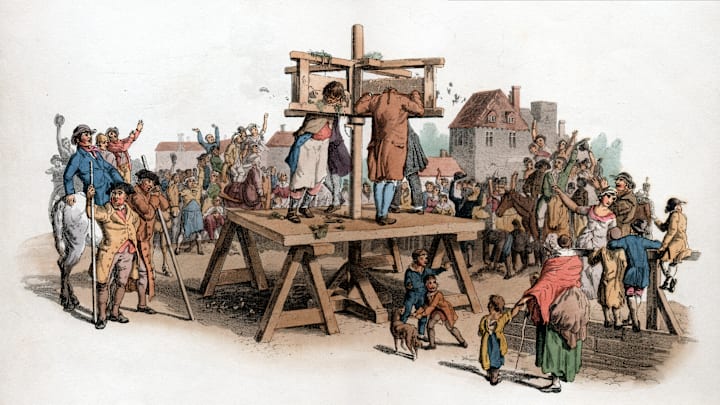Humans have been inflicting creative forms of punishment on each other since the dawn of civilization. From Ancient Greece to Medieval England, here are some particularly brutal torture devices that have thankfully been phased out of our penal systems.
1. Heretic’s Fork
This torture device gained popularity during the Spanish Inquisition in the Middle Ages and consisted of a collar outfitted with a double-pronged fork. The sharp ends of the tool forced the wearer to hold their head back to avoid getting stabbed through the upper chest or lower jaw. The fork wasn’t designed to kill the person being tortured if they relaxed their head—but it would have caused some serious pain.
2. Thumbscrew

One of the most infamous instruments of torture to come out of Medieval Europe is the thumbscrew. As the name suggests, the device compressed the victims’ fingers or thumbs through the turning of a screw. Such contraptions were often metal and had compartments for crushing two digits at a time.
3. Scold’s Bridle

In addition to the physical discomfort, this European torture device from the 16th and 17th centuries was designed to humiliate the victim. In this era, the word scold described women (and occasionally men) who engaged in such societally unacceptable behaviors as fighting, gossiping, and speaking out of turn. These “out-of-control” individuals were sometimes punished by being forced to wear a metal bridle on their heads in a public setting. Some versions of the apparatus included a spiked bit that dug into the wearer’s mouth and stopped them from speaking.
4. Scavenger’s Daughter
This brutal device originated during the reign of King Henry VIII in the 16th century, and it’s believed that Sir Leonard Skeffington, a lieutenant of the Tower of London, invented it for the prisoners he was overseeing. The metal rack had shackles for the neck, hands, and feet that formed a narrow A shape when locked into place. It was designed to scrunch the wearer into a position that became extremely uncomfortable over long periods of time.
5. Lead Sprinkler
This instrument was nearly identical to the tools priests use to sprinkle holy water on parishioners, but confusing the two would be disastrous. Instead of tepid water, these torture devices were filled with molten lead. Torturers dripped the liquid metal into the faces of their victims, sometimes killing them in the process.
6. The Rack

If you’ve heard of one Medieval torture device, it’s likely the rack. The Duke of Exeter introduced the contraption to the Tower of London in the 15th century, earning it the nickname “The Duke of Exeter’s Daughter.” Victims were made to lie down on the table-like surface and have their hands and feet bound with ropes. The ropes were attached to rollers that, when turned, stretched the victim’s limbs in opposite directions. The force eventually tore their muscle ligaments and dislocated their arms and legs, making it a simple yet effective mode of torture.
7. Judas Cradle
This was one of the nastier torture devices to come out of the Spanish Inquisition. The Judas cradle had four legs like a chair, but designer Ippolito Marsili added a pointed wooden pyramid instead of a comfortable seat. Victims were positioned over it and either lowered down with ropes or made to stay above it on their own until they grew exhausted and lowered themselves. This inflicted excruciating wounds upon the oh-so-sensitive area between the legs.
8. Breaking Wheel
Wheel torture dates back to Ancient Greece and Rome, and it regained popularity in Medieval Europe, where legends tell of torture victims being strapped to large wheels and rolled downhill. The way the tool was used in real life was less dramatic, though just as painful: After having their arms and legs tied to the spokes, victims were bludgeoned to death with a large hammer. The remains of victims from around the 14th century show that executioners went for less-vital body parts first, before delivering deadly blows to the face and stomach.
9. Pillory

Relatively tame compared to the other tools on this list, the pillory wasn't built to cause mortal harm—the primary goal was public humiliation. The victims had their heads and hands locked into a wooden frame for hours at a time, while their peers came to jeer at them. Though it wasn’t deadly on its own, a handful of people perished in the pillory, usually from stones or other large objects chucked by onlookers. This mode of retribution was used throughout the Medieval era and was finally outlawed in Britain in 1837.
10. The Stake

Death at the stake was made famous by witch trials in Medieval Europe, but the practice of burning people alive dates as far back as Babylonia and Ancient Israel. The stake method was simple: The accused was strapped to a wooden post before being set ablaze, ending with the victim burning alive. To help mitigate their suffering, some victims were outfitted with a box of gunpowder that killed them instantly the moment it ignited. Others had a chain noose around their necks that would quickly hang them once the ropes burned away.
11. Brazen Bull

This twisted invention earns points for creativity. According to the Bibliotheca Historica, a historical account by the Ancient Greek writer Diodorus Siculus, the craftsman Perilaus designed the Brazen Bull for the Greek tyrant Phalaris in the 6th century BCE. The hollow bronze structure was shaped like a bull with a door for inserting victims. Once it was loaded, a fire was lit under the bull and the victim was cooked alive.
The most disturbing aspects of the device lay in the details. The mouth of the statue was outfitted with pipes that made the victims' screams sound like the bellowing of a bull. It's hard to imagine such a cruel contraption ever existing, and there's a chance it never did. Some modern scholars think that Diodorus Siculus's account was at least exaggerated, if not fabricated.
